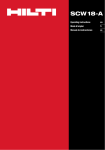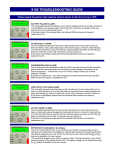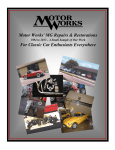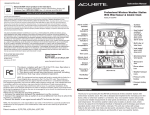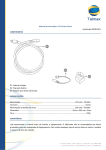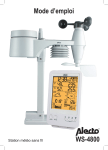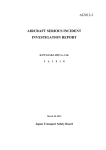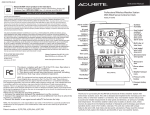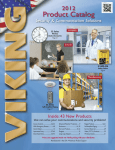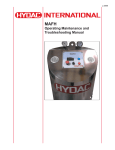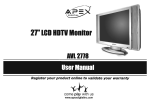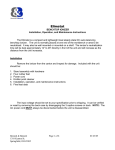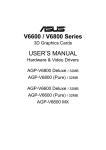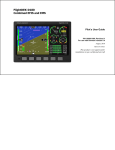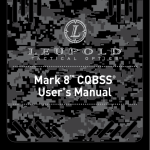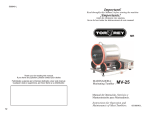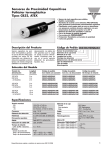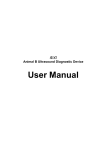Download Model 10 ver 4.2 Operational Manual
Transcript
STI MODEL10 (Ver. 4.2) Capsule Filling Machine OPERATION AND MAINTENANCE MANUAL STI MODEL 10 Ver. 4.2 SPECIFICATIONS Dimensions: 30” deep 55” wide 73-1/4” high (with casters) Weight: Approximately 1,000 pounds Floor space to operate: Motors: 36 square feet All drive independent units ¼ HP AC for rectifier ½ HP AC for auger ½ HP AC for rotary table 1 ½ HP AC 3 phase vacuum pump drive o All drives are sealed gear boxes with toothed belt power transmission o Oil-Less vacuum pump is self-contained inside. The machine pump requires no water. o Qualified technical service engineers are available upon request. o Size changeover: 30 minutes or less: no realignment required. o Uses standard Model 8TM style filling ring. o Product run on Model 8TM type machine does not require reformulation. o Uses standard Model 8TM type machine auger. o Designed to fill popular capsule sizes. o Will operate on 190,200,208,220, 230,380,400,415,440,460 or 480 volt, three phase power. Uses approximately 2 KW. o Requires 80 psi air service at approximately 3 CFM air flow. STI Model 10 Ver. 4.2 TABLE OF CONTENTS Chapter 1: Introduction SECTION TITLE PAGE 1.1 Introduction and General Recommendations ……… EC Compliance Statement – General Safety Regulations & Warnings 2 3 1.11 1.1.1 1.1.2 1.1.3 Overview Purpose of the Machine Features of this Model Chapter Contents 6 6 7 1.2 1.2.1 1.2.2 Capsule Information Size Environmental Conditions 7 7 7 1.3 1.3.1 1.3.2 1.3.3 The Capsule Rings Introduction Diagram Composition 8 8 8 8 1.4 1.4.1 1.4.2 1.4.3 1.4.4 1.4.5 1.4.6 The Rectifying system Introduction The Capsule Path Phases of Operation Capsule Entry Capsule Positioning (Rectification Capsule Feeding (and Separation 9 9 9 10 10 10 12 1.5 1.5.1 1.5.2 1.5.3 The Filling System Introduction System Diagram Filling the Capsules 13 13 13 14 1.6 1.6.1 1.6.2 1.6.3 1.6.4 The Closing (or Closure) System Introduction Assembly Diagram Closing the Capsule Capsule Ejection 15 15 15 15 16 1.7 1.7.1 The Air/Vacuum System Introduction 16 16 1.8 1.8.1 1.8.2 1.8.3 The Computer (Control) System Introduction Push Buttons Inputs HMI Touch Panel Inputs 17 17 17 17 Table of Contents - Page 1 of 4 SECTION TITLE PAGE 1.8.4 1.8.5 1.8.6 1.8.7 Sensor Inputs Controller Outputs: Motors Controller Outputs: Solenoids Controller Outputs: Counter 17 18 18 18 1.9 1.9.1 1.9.2 1.9.3 1.9.4 1.9.5 Specifications for Model 10 Dimensions Weight Motors Power Air (Vacuum) 19 19 19 19 19 19 2.1 2.1.1 2.1.2 2.1.3 2.1.4 2.1.5 Overview Definition Machine Preparation Machine Operation Chapter Contents Warning Labels and Locations 2 2 3 3 3 4 2.2 2.2.1 2.2.2 Part A: MACHINE PREPARATION How to Fill the Powder Hopper Introduction Procedure 5 5 5 2.3 2.3.1 2.3.2 How to Load the Capsules Introduction Procedure 6 6 6 2.4 2.4.1 2.4.2 Part B: MACHINE OPERATION Overview Three stages Flow of operation 7 7 7 2.5 2.5.1 2.5.2 2.5.3 2.5.4 2.5.5 2.5.6 2.5.7 Rectifying, Filling and Closing the Capsules Definition Prerequisites Procedures Adjustments-Setting the Vacuum Rectifying the Capsules Filling the Capsules Closing the Capsules 7 7 7 8 11 12 13 14 CHAPTER 2: ROUTINE OPERATION Table of Contents - Page 2 of 4 CHAPTER 3: CAPSULE SIZE CONVERSION SECTION TITLE PAGE 3.1 3.1.2 3.1.3 Overview Size Table Change Parts 2 3 4 3.2 3.2.1 3.2.2 How to Convert the Rectifier Assembly Diagram Procedure 5 5 6 3.3 3.3.1 3.3.2 How to Convert the Closure Assembly Diagram Procedure 12 12 12 4.1 4.1.1 4.1.2 4.1.3 Overview Maintenance Repair Troubleshooting and Repair 2 2 2 2 4.2 4.2.1 4.2.2 4.2.2 How to Clean the Powder Hopper Introduction Procedure Powder & Pellet Shoe Information 3 3 3 6 4.3 4.3.1 4.3.2 How to Replace the Vacuum Filter Introduction Procedure 9 9 9 4.4 Air and Electrical Diagrams 9 4.5 4.5.1 4.5.2 4.5.3 4.5.3 How to Adjust the Proximity Switches Introduction Switch Adjustment-Rectifier/Fill Table Switch Adjustment-Hopper Position Switch Adjustment-Closing Position 10 10 11 11 12 4.6 4.6.1 4.6.2 How to Replace the Fuses & Reset Circuit Breakers Introduction Procedure ( Circuit Breakers and Fuses) 13 13 13 4.7 The Control Box 15 4.8 Computer 15 4.9 4.9.1 4.9.2 4.9.3 How to Adjust the Machine’s Air Pressure Introduction Adjustment Knob Location Pressure Adjustments 16 16 16 17 CHAPTER 4: MAINTENANCE AND REPAIR Table of Contents - Page 3 of 4 SECTION TITLE PAGE 4.10 4.10.1 4.10.2 How to Adjust the Closing Station Introduction Procedure 18 18 18 4.11.1 4.11.2 How to Adjust the Filling Shoe to Capsule Body Ring Clearance – Powder & Pellet Introduction Procedure 19 19 20 4.12 4.12.1 4.12.2 Becker Pump Introduction Procedure 21 21 21 CHAPTER 5: TROUBLESHOOTING & MACHINE MAINTAINANCE 5.1 5.1.1 5.1.2 5.1.3 5.1.4 Overview Definition Troubleshooting Guide Additional Aids MACHINE MAINTAINANCE 2 2 2 2 6 CHAPTER 6: RECOMMENDED SPARE PARTS LISTS 6.1 6.2 6.3 6.4 6.5 Rectifier Station Fill Station Closing Assembly Fuses Tools and Accessories Table of Contents - Page 4 of 4 2 3 3 4 4 CHAPTER 1 INTRODUCTION to the STI MODEL 10 Ver. 4.2 CAPSULE FILLING MACHINE Chapter 1 – Page 1 of 19 SCHAEFER TECHNOLOGIES, INC. STI MODEL 10 Ver. 4.2 CAPSULE FILLING MACHINE USER’S MANUAL Valid from serial No. __________ thru __________ INTRODUCTION AND GENERAL RECOMMENDATIONS INTRODUCTION This User’s Manual has been compiled in compliance with Machinery Directive: 2006/42/EC and CE Marking Directive 93/68/EEC to provide the user with information about how to use and maintain the machine correctly. It is compulsory to read this manual. It is our intention that the information contained in this manual will be a valid aid for your work. This information is based on data and on our best current knowledge. Carefully read this manual, including the recommendations and suggestions. No part of this manual may be copied or passed to third parties without the prior written consent of Schaefer Technologies, Inc. We advise you to carefully read this manual, as it is essential to install, check and service the machine correctly in order to keep it in a perfectly efficient working order. The manual contains tables, designs and diagrams, which will help you to get to know the machine in detail. Please don’t hesitate to contact us if you find that an explanation has been omitted or is unclear. NAMEPLATE For any servicing or overhaul operations not included in this manual or for any other technical problem which may arise, our Technical Personnel are available to provide you with information and to discuss any necessary action to take. When contacting us, please indicate the data on the machine’s nameplate. PRELIMINARY REMARKS • The drawings and designs which show the system should be considered as reference and not necessarily faithful in every detail. • The system dimensions and specifications contained in this manual are not binding and may be changed without warning. • The designs and all of the other documents supplied as part of the system are the property of Schaefer Technologies, Inc. The system is covered by a guarantee and a contract of purchase. During the period in which the machine is under guarantee, any repairs which have not been authorized by Schaefer Technologies, Inc. and are carried out on the same machine will automatically make the warranty void. Chapter 1 – Page 2 of 19 The user must take particular note of the safety warnings and information indicated by the following symbols and labels in this manual. Mandatory Danger Lockout Prohibited Read manual Wear eye protection Wear safety gloves Electrical Current Specification Electrical Voltage Specification Caution – Pinch Point Caution – Pinch point hazard. Keep hands clear. Warning – Shear hazard. Keep hands clear from under blades. Turn power off before servicing. Chapter 1 – Page 3 of 19 Warning – Rotating parts inside. Keep hands clear. Lockout/tagout before servicing. Warning – Hazardous Voltage Danger Hazardous voltage. Contact may cause electric shock or burn. Turn off and lockout system power before servicing. Read and understand manual before servicing. Only qualified personnel should service this panel Warning – Avoid injury. Do not operate with guards removed. Replace guards before operating machine. For the safety of the Personal .DO NOT modify of remove any of this equipment’s guards, safety devices or warning labels. Warning – Read and understand operator’s manual before using this machine. Failure to follow operating instructions could result in injury or damage to the equipment. Emergency Stop GENERAL SAFETY REGULATIONS • • • • • • • • • THESE SAFETY REGULATIONS HAVE BEEN DRAWN UP FOR YOUR OWN SAFETY. The strict observance of the safety regulations will reduce the risks of accidents for both you and or others. DO NOT attempt to move, install or operate the system without having first read and fully understood this manual. If in doubt, ask your supervisor. Make sure that all of the guards and protective covers are in place BEFORE starting the machine. NEVER leave tools, mechanical parts or other unsuitable material on or in the machine. If a failure should occur, push the emergency stop button. NEVER WORK ON THE MACHINE WHILE IT IS RUNNING. Pay particular attention even when the main switch is in the “OFF” position, because the electrical power supply cables are still live. BEFORE restarting the production cycle after carrying out maintenance operations or repairs on the machine, make sure that all of the guards and protective covers are fitted correctly. Always be cautious, remember that your safety and that of fellow workers depend on you. When moving or lifting components of the machine, make sure that all the regulations for these operations are respected. Chapter 1 – Page 4 of 19 • • • • • • • • SPECIAL WARNINGS The personnel who operate this machine must know and scrupulously observe the general safety regulations. If these regulations are not observed, this may cause injury to workers and damage components of the machine. The maintenance operations must be carried out with the machine at a standstill. Lockout machine prior to servicing. Failure to follow operating instructions could result in personal injury or damage to the equipment. The user must make sure that all of the instructions in the manual are followed to the letter. Any tampering with the safety systems of the machine done for any reason, will be at the user’s own responsibility and risk. Do not ever try to bypass the safety systems or make them ineffective. For the machine smooth operation it is absolutely necessary to observe the speed, temperature and tension limits, along with all the indications given which the client must in any case respect. Furthermore, the environmental conditions must be taken into account for the installation of the machine. The national laws governing the use of this type of machine must also be observed. WARNING Schaefer Technologies, Inc. declines any responsibility for damage which may derive from the noncompliance with the above-mentioned warnings. The declaration of conformity enclosed with this manual has been compiled by the manufacturer in compliance with the European Directive and defines the machine as “safe”. The manufacturer’s declaration will become null and void if the machine is tampered with, modified, has its fixed and moving protective guards removed or is used for purposes other than those for which it was designed. The manufacturer disclaims all responsibility for any accidents or damage that may arise. Chapter 1 – Page 5 of 19 CHAPTER 1 1.1 Overview 1.1.1 Purpose The MODEL 10 capsule-filling machine (shown above) is a semi-automated means of filling capsules (sizes 000 through 4, DB-A, DB-B and DB-AA) with powder or pellets. 1.1.2 Features of this Model This model provides many helpful features to aid efficiency and productivity in the capsule-filling process: • capsule feeding from the hopper • automatically stops after one revolution of capsule rings • automatic positioning of powder hopper over the ring set • dedusting screen to promote clean capsule Chapter 1 – Page 6 of 19 1.1 Overview 1.1.3 Chapter Contents The following sections introduce the machine and its parts, as well as the principle of operation of the various machine “systems”. These systems work together to provide you with an easy-to-use, efficient capsule-filling machine. The main topic headings are shown below: SECTION 1.2 1.3 1.4 1.5 1.6 1.7 1.8 1.9 TOPIC Capsule Information The Capsule Rings The Rectifying System The Filling System The Closing System The Air/Vacuum System The Control System Machine Specifications 1.2 Capsule Information 1.2.1 Size The MODEL 10 is designed to fill capsule sizes (sizes 000 through 4, DB-A, DB-B and DB-AA). The appropriate parts must be installed each time a different capsule size is to be run (refer to Section 3.1.2). Orientation (positioning) of the capsules during processing is important. Capsules in the cap-up and cap-down positions are shown below: Capsule Positions Capsule positioning (rectification) is described in Section 1.4. 1.2.2 Environmental Conditions The humidity and temperature of the area around the machine will influence the flow of the capsules. High humidity especially can promote “stickiness” in the capsules, leading to jams in the rectifying system. Chapter 1 – Page 7 of 19 1.3 The Capsule Rings 1.3.1 Introduction The capsule rings hold the capsules during the capsule-filling process. The capsule ring set consists of a matched pair of rings (body and cap rings) designed to accommodate a particular size of capsule. Because of this, only a matched set must be used for the appropriate capsule size. Incorrectly matched rings (rings for two different capsule sizes) will not seat correctly when joined. Capsules of one size cannot be processed in a ring set designed for another size. 1.3.2 Diagram The capsule ring set is shown in the diagram below: CAP RING BODY RING Capsule Ring Set 1.3.3 Composition These rings are machined from aluminum. It is important that you handle the rings carefully to prevent nicks in the metal that can cause improper seating of the rings with one another. If nicks occur, capsules may not be injected properly into the ring set or may fail to separate. Chapter 1 – Page 8 of 19 1.4 The Rectifying System 1.4.1 Introduction In order for the capsules to be opened and filled, they must all be positioned (oriented) in the capsule rings in the same direction, bodies down. This process is called rectification and is performed by the rectifying system. 1.4.2 The Capsule’s Path The diagram below shows the typical path of a capsule through the rectifying system: RECTIFIER ASSEMBLY CAPSULES Capsule Path Chapter 1 – Page 9 of 19 1.4 The Rectifying System 1.4.3 Phases of Operation There are three phases of capsule processing in the rectifier assembly: • capsule entry • capsule positioning (rectification), and • capsule feeding (into the ring set). 1.4.4 Capsule Entry The capsule hopper at the top of the assembly holds capsules until they are fed by gravity into one of the holes in the upper feed block. At this point, the capsules are positioned both cap-up and cap-down. As the capsules below them are processed, the capsules move down through the holes in the feed block into the rectifier block. 1.4.5 Capsule Positioning (Rectification) As shown below, the capsules first sit in the rectifier block positioned in both directions (cap-up or cap-down): Random Positions – Rectifier Block Chapter 1 – Page 10 of 19 1.4 The Rectifying System 1.4.5 Capsule Positioning (Rectification) The rectification of the capsules within the rectifier block by the rectifying blade is shown below: Capsule Sitting Cap-up: blade enters and flips capsule up. Capsule Sitting Body-up: blade enters and flips capsule down. Capsules Flipped by Blade The final position (orientation) of both capsules in the example below are identical, the bodies positioned toward the rectifier block exit. Capsules Positioned for Feeding Chapter 1 – Page 11 of 19 1.4 The Rectifying System 1.4.6 Capsule Feeding (and Separation) When the RECTIFIER START button is pushed, capsules are ejected, body first, from the rectifier block by Delrin pins. They are pushed into the rotation module and are rotated downward by an air stream through the guide chute and into the ring set. The larger sized cap of the capsule is retained in the cap ring as the capsule body is separated from the cap and pulled into the bottom body ring by vacuum originating from below the ring. The turntable supporting the ring set rotates continuously until the ring is filled with capsules and then automatically stops. Chapter 1 – Page 12 of 19 1.5 The Filling System 1.5.1 Introduction The filling system consists of the: • Powder hopper • Auger and wiper arm • Filling turntable 1.5.2 System Diagram The filling system is diagrammed below: POWDER HOPPER WIPER ARM CUTOUT FILLING SHOE BLOCK FILLING SHOE CAPSULE BODY RING FILL TURNTABLE Filling System Chapter 1 – Page 13 of 19 1.5 The Filling System 1.5.3 Filling the Capsules The amount of material to be added to the capsules is regulated by the auger speed as well as the turntable speed. These are both adjusted with the HMI Touch Screen on the Drive Setup page. After the desired material has been placed in the powder hopper and the capsules have been separated, the filling process can begin. Only the loaded lower body ring is used in the filling process. After the rings are separated, the cap ring is stored on the cap ring holder and the body ring is placed on the filling turntable. When the FILL START button(s) are pushed, the powder hopper automatically swings into place and the auger, wiper arm, and turntable begin to rotate. The powder is forced out of the hopper by the auger, filling the capsules while the table rotates continuously at your previously designated speed until all the capsules are filled. Filled Capsules (Body Ring) After one complete rotation, the turntable automatically stops and the powder hopper will swing back to its standby position. The cap ring is then reseated on the body ring and the ring set is placed on the closing station (next section) where the capsule caps and bodies are rejoined. Chapter 1 – Page 14 of 19 1.6 The Closing (or Closure) System 1.6.1 Introduction The separated capsules, after being filled, must be rejoined to complete the capsule filling process. This is accomplished in the closing station, located at the left lower portion of the machine. 1.6.2 Assembly Diagram The closing station is shown below: CLOSURE PAD RING SET WING CLAMP PEG RING LOCATOR PINS DEDUSTER The Closing Station HANDLE 1.6.3 Closing the Capsule The ring set (cap and body rings) is seated on the locator pins over the peg ring and secured by a wing clamp. When ready, the drawer (the closing station) is pushed into the machine until a switch is activated at the rear of the closed drawer. Note: When the switch is activated closing the capsules, the ring counter advances by (1) one. If needed the capsules may be closed a second time, if done within 7 seconds, WITHOUT advancing the ring count. IN CLOSING POSITION Chapter 1 – Page 15 of 19 1.6 The Closing (or Closure) System 1.6.4 Capsule Ejection The closed capsules are ejected from the ring set by inverting the peg ring/ring set module so that the capsules fall out (by gravity) onto the deduster screen. The excess powder is shaken off by the fall, and capsules then slide into a receptacle of your choice (previously positioned below the closing station). After righting the closure assembly, the ring set can then be removed (by releasing the wing clamp and lifting straight up) and returned to the rectifier turntable to receive the next load of empty capsules. CAPSULES BEING EJECTED 1.7 Air/Vacuum System 1.7.1 Introduction A constant supply of air is introduced into the vacuum/air system of the capsule filling machine to provide the following: • air to the rectifier manifold, powder hopper air cylinder and closing air cylinder. • air to operate the vacuum/air valve. • vacuum for capsule separation at the rectifier (feed) table. Settings for this system are discussed in Section 4.9 “How to Adjust the Machine’s Air Pressures”. Chapter 1 – Page 16 of 19 1.8 The Computer (Control) System 1.8.1 Introduction The MODEL 10 operation is controlled by the Telemecanique programmable controller. Through its inputs, the computer reads in signals and turns on one or more of its outputs, based on the logic programmed into the computer memory. The input and output functions controlled by the computer include: • starting and stopping motors • turning on solenoids • reading sensors and switches These signals (during routine operation) are described in the sections below. 1.8.2 Push Button Inputs The RECTIFIER START button turns on the rectifier turntable to fill a ring with empty capsules. The RECTIFIER STOP button stops the motion of the rectifier only. (This might be necessary in the event of a capsule jam.) The FILL START button(s) turn on the auger and the filling table to fill a ring of empty capsules with product. The large, red EMERGENCY STOP button will shut down entire machine. The Main Power switch turns on power to the machine. 1.8.3 HMI Touch Panel Inputs (see Chapter 5) 1.8.4 Sensor Inputs • The RECTIFIER TABLE sensor signals the Programmable Controller that the rectifier table has made one complete revolution. • The POWDER HOPPER FILL POSITION sensor signals that the powder hopper is in place over the fill table and starts the table and auger rotation automatically. • The POWDER HOPPER HOME POSITION sensor signals that the powder hopper is in the home position. (This is required for machine startup) • The FILL TABLE HOME sensor signals the Programmable Controller that the filling table has made one complete revolution. • The Closing Unit sensor ensures that the sliding ring drawer (with ring) is in the closed position and sends the signal to begin the closing process. Chapter 1 – Page 17 of 19 1.8 The Computer (Control) System 1.8.5 Controller Outputs: Motors The RECTIFIER MOTOR powers the rectifier head and the rectifier turntable as capsules are positioned then inserted into the ring set. The FILL TABLE MOTOR turns the turntable beneath the powder hopper as empty capsule bodies are filled with material. The AUGER MOTOR powers the auger for continuous powder distribution into the empty capsule bodies. 1.8.6 Controller Outputs: Solenoids The HOPPER POSITION SOLENOID (SOL1) controls the air cylinder that Swings the powder hopper over the fill table and back to its standby position. The RECTIFIER VACUUM SOLENOID (SOL2) supplies the vacuum needed to separate the capsules at the rectifier turntable and forced air to the rotation module. The SOFT START SOLENOID (SOL3) controls the air dump valve. The CAPSULE CLOSING SOLENOID (SOL4) controls the air cylinder that reassembles the capsules by pressing (with the peg ring) the capsule bodies up into the caps. * See drawing 33982905 for locations 1.8.7 Controller Output: Counter The RING COUNTER counts the number of completed capsule rings. Chapter 1 – Page 18 of 19 1.9 Specifications for the STI MODEL 10 Ver. 4.2 1.9.1 Dimensions • • • Height – 73-1/4” inches (with casters) Width – 48 inches Depth – 30 inches This machine requires 36 square feet of floor space. 1.9.2 Weight This machine weighs approximately 1,000 lbs. 1.9.3 Motors Horsepower (hp) 1/4 1/2 1/2 1-1/2 1.9.4 Power • • • • 1.9.5 Air • • • Current* AC AC AC AC Assembly Location Rectifier Auger Fill Table Vacuum Pump Drive (3phase) “BECKER” 190,200,208,220,230,380, 400,415,440,460 or 480 volt 50 or 60 cycle 3 phases Total load is approximately 2.0 KW 80 psi 3 cfm 5.5 Bar Chapter 1 – Page 19 of 19 CHAPTER 2 ROUTINE OPERATION Model 10 Ver. 4.2 Chapter 2 - Page 1 of 15 CHAPTER 2 ROUTINE OPERATION 2.1 Overview 2.1.1 Definition Routine operation includes the entire process of filling capsules and can be separated into two stages: Machine Preparation (Part A) Machine Operation (Part B) The flow diagram below presents an overview of the steps in routine Operation of the capsule filling machine: MACHINE PREPARATION l LOAD THE CAPSULES l FILL THE POWDER HOPPER l MACHINE OPERATION l POWER ON THE MACHINE l PLACE THE RING SET ON THE RECTIFIER TURNTABLE l PRESS THE “RECTIFIER START” BUTTON l PLACE THE BODY RING ON THE FILL TURNTABLE l REMOVE THE CAP RING l PRESS THE TWO “FILL” BUTTONS l JOIN THE CAP & BODY RINGS l PLACE THE RING SET ON THE CLOSING STATION l PUSH THE STATION INTO THE MACHINE l RETRIEVE THE CLOSING ASSEMBLY l INVERT THE ASSEMBLY TO DUMP THE CAPSULES Chapter 2 - Page 2 of 15 2.1 Overview 2.1.2 Machine Preparation As you can see, Machine Preparation consists of two procedures: • loading the capsules and • filling the powder hopper. These are performed by the operator before the capsule filling process begins. 2.1.3 Machine Operation The HMI TOUCH SCREEN: At any time after Log On you can access the HELP SCREEN by pushing the “HELP” button. As the machine’s operator, you assist in each stage of the capsule filling process. This process includes: • positioning and separating the capsule • filling the capsule • closing and ejecting the capsule Each stage is automated within itself, but you initiate each stage through the control panel: Control Panel You also provide the transition from one stage to the next, maintaining a smooth flow of the entire process. 2.1.4 Chapter Contents Step-by-step procedures for machine preparation and operation Are found in the remaining sections of this chapter. Chapter 2 - Page 3 of 15 WARNING Read and understand operation manual prior to operating or servicing this machine. Failure to follow operating instructions could result in personal injury or damage to the equipment Chapter 2 - Page 4 of 15 Part A: MACHINE PREPARATION Read and understand operation manual prior to operating or servicing this machine. Lockout machine prior to servicing. Failure to follow operating instructions could result in personal injury or damage to the equipment. 2.2 How to Fill the Powder Hopper 2.2.1 Introduction The desired filler material must be placed in the powder hopper before starting the filling process. NOTE: If there currently is material in the hopper and you are changing to a different one, refer to the cleaning procedure in Section 4.2 before proceeding. 2.2.2 Procedure Follow this procedure to fill the powder hopper: 1) Raise the powder hopper lid and, using a scoop, add the product. THE MAXIMUM POWDER FILL HEIGHT SHOULD BE APPROX. 2 INCHES ABOVE WHERE STRAIGHT DIAMETER OF THE HOPPER AND THE TAPERED AREA MEET. MAX FILL 2 Inches above this area. 2) 3) Fill the hopper according to the number of capsules to be filled. As you are operating the machine, keep the hopper full enough to maintain the weight required. Clean up any spilled material before starting machine operation, either by vacuuming, brushing to the powder catch-tray, or wiping with a clean, damp cloth. Chapter 2 - Page 5 of 15 2.3 How to Load the Capsules 2.3.1 Introduction These are the steps in preparing capsules for routine operation: NOTE: Be sure the capsules to be loaded are the correct size for the parts on the machine. If a different size is to be used, refer to Section 3 before proceeding. 2.3.2 Procedure 1) Remove the lid from the capsule container. 2) Hand-feed (scoop) the capsules into the top of the capsule hopper. CAPSULE HOPPER NOTE: The rate of flow of capsules from the capsule hopper to the top of the rectifier can be controlled by slightly opening or closing the hopper door. HOPPER DOOR Chapter 2 - Page 6 of 15 Part B: MACHINE OPERATION Read and understand operation manual prior to operating or servicing this machine. Failure to follow operating instructions could result in personal injury or damage to the equipment. 2.4 Overview 2.4.1 Three Stages Once the machine is properly prepared, the following procedures are performed by the machine with the operator’s assistance: • • • positioning and separating the capsules filling the capsules closing and ejecting the capsules 2.4.2 The Flow of Operation The procedures described above always occur in the sequence shown, with The machine powered ON throughout. The vacuum pump remains ON throughout the procedures as well. As you gain more experience, you will be able to process capsule rings in two or three stages of operation at the same time. The machine is designed to allow a smooth flow through these different stages. 2.5 RECTIFYING, FILLING AND CLOSING THE CAPSULES 2.5.1 Definition The term rectify means to make unidirectional (one direction) or set right. The rectifier assembly is so named because this is where all capsules are positioned body-down to be drawn (by vacuum) into the capsule filling rings for separation. 2.5.2 Pre-requisites - Before Starting Before the filling process can begin, the machine must have been properly prepared: • Powder hopper filled (section 2.2) • Capsules loaded (section 2.3) Chapter 2 - Page 7 of 15 2.5 RECTIFYING, FILLING AND CLOSING THE CAPSULES 2.5.3 Procedure – Machine Startup and Display Settings Your assistance in positioning (rectifying) and separating the capsules consists of the following steps: 1. Make sure all interlocked doors are closed and all guards and panels are in place and secured with safety screws. Make sure the powder hopper is at its HOME position. Turn on the master disconnect switch on the right side of machine. 2. Pull out the Emergency Stop button. HMI TOUCH SCREEN KEY LOCKED BOX MASTER DISCONNECT SWITCH MAIN POWER EMERGENCY STOP (PUSH/PULL) Note: When the main disconnect is turned ON – If there is an alarm issue (ie, rectifier door open, fill hopper not at home position, no air to the machine, etc.) the Alarm screen will display instead of the Log On screen. As the alarm condition is corrected, the machine status is automatically corrected (this does not remove the alarm message from the screen – the alarm acknowledgement button must be pushed for each alarm message to remove it from the screen). When all alarms (except for Machine Ready) have been satisfied, pushing the “Back Button” will take you to the Log On screen. ALARM SCREEN LOG ON SCREEN Alarm Acknowledgement Button CURRENT USER ID 0 [No One Logged ON] -1 SUP01 [Supervisor 1] 4 OP1 [Operator 1] 2 BACK Button HOME BACK UNLOCK 3. Allow the touch screen to come on – it will display the Log On Screen • Touch User Name – this will bring up the keypad. Key in your user name and push Enter. • Touch Password - this will bring up the keypad. Key in your password and push Enter. • First Push the Unlock and then the Push the Home button (MUST be pushed in this sequence)– this will take you to the MAIN SCREEN. Chapter 2 - Page 8 of 15 On all screens where there is a “BACK” button and a “MAIN” button – Pressing the BACK button takes back to the prior screen. Pushing the MAIN button takes you to the MAIN SCREEN. 2.5 RECTIFYING, FILLING AND CLOSING THE CAPSULES 4. Push the Machine Status button to advance to the Machine Status screen. (Machine Status Screen is only accessible thru the Main Screen) MAIN SCREEN Main Power MACHINE STATUS SCREEN 5. Push the Main Power button on the HMI (Human Machine Interface) Touch Screen box. (The Machine Ready Indicator will light.). Push the Vacuum ON Button to activate air to the machine. (The MACHINE AIR ACTIVE light should turn green). At this time the FILL HOPPER AT HOME and the RECTIFIER AT HOME should be lit. NOTE: Upon initial Machine Startup or Machine Restart due to emergency stop or door interlock shutdown, after the VACUUM ON button is pressed, there is a slight delay as the system is allowed to reach full air and vacuum pressure. The machine is now ready to operate. 6. Press the CLOSING STATION button to access the closing station screen. CLOSING STATION SCREEN The SHIFT RING COUNTER and the TOTAL RING COUNTER may be reset to zero. See Chapter 5 for instructions. This screen also gives a visual reference for the closing station delay. The closing station has the ability to repeat the closing cycle WITHOUT advancing the counter as long as those closing cycles are completed within 7 seconds of the first cycle. The counter (displayed as 12 now) is in seconds and starts at 1 and counts to 7. During this time the green light is on and the capsule closing cycle may be ran WITHOUT advancing the counter. At the end of 7 seconds the Green Light goes out and the closing cycle WILL advance the counter. Chapter 2 - Page 9 of 15 2.5 RECTIFYING, FILLING AND CLOSING THE CAPSULES 2.5.3 Procedure – Machine Startup and Display Settings 7. The Formula Menu Screen allows the Supervisor to create custom menus for the various products that are being filled. See Chapter 5, Pg.9 thru 12 for detailed formula and recipe setup instructions. Note: When the Formula_01 page first comes up, the numbers in the Fill Drive, Auger Drive and Rectifier Drive represent the current state (last speed ran) that the drives are in – NOT NECESSARILY what the formula requires. 8. Operator – • Accesses the Recipe Group and Recipes. This displays the list of recipes available to run. • Pushing the SEND BUTTON FOR TWO SECONDS” – THIS WILL CALCULATE AND INSERT THE CORRECT VALUES INTO THE MACHINE for the Fill Drive, the Auger Drive and the Rectifier Drive. (This should be verified on the DRIVE FREQUENCY PAGE.) • On the Formula Menu screen - pressing the STATUS Button displays the information for the “ADJUST VACUUM TO”, the “ADJUST AIR FLOW TO” and the “ADJUST CLOSING STATION TO” gives the operator the Air and Vacuum settings for the calculated formula. (Note: These must be manually set by the operator. FORMULA MENU Drive Info FORMULA STATUS PAGE DRIVE FREQUENCY PAGE NOTE: For BEADS the AUGER MOTOR SPEED is set to ZERO [0]. Drive Speed Running Speed Note: Drive speed indicator and drive reset buttons require “Supervisor Rights”. Pushing any of these buttons will access the LOG ON SCREEN allowing for a SUPERVISOR to Log On. Reset Chapter 2 - Page 10 of 15 2.5 RECTIFYING, FILLING AND CLOSING THE CAPSULES 2.5.4 Adjustments – Setting the Vacuum 1. Vacuum Level This is set by the dial on the rear of the vacuum pump which is accessed by the rear door. The vacuum level is checked via the gauge in the foot well. Note: Valve needs to be in the OFF position to set pump. See photo below. Pump Valve adjustment knob – Set to 15inHg max. for most applications. Valve shown in OFF Position 2. Vacuum Flow The amount of flow at the vacuum port block can be regulated by the valve adjacent to the vacuum gauge. As the valve is rotated from the closed position towards the open position, filtered air is introduced into the vacuum system reducing the amount of vacuum. (A setting of 8inHg to 15inHg is suitable for most applications. Vacuum higher than 15inHg will require raising the pump pressure accordingly) Note: The Vacuum can be adjusted anytime the Rectifier Cycle is idle. Maximum pump pressure is 24inHg. - High pressures can shorten pump life. • Too much vacuum – the capsules will bounce and the caps will fly off. • Not enough vacuum will result in poor separation Vacuum Port Block Valve – in full Open Position Chapter 2 - Page 11 of 15 Valve – in full Closed Position 2.5 RECTIFYING, FILLING AND CLOSING THE CAPSULES (continued) 2.5.5 Procedure – Rectifying the capsules The rectifier station should be pre cycled to make sure that the rectifier is filling all locations on the filling ring. RECTIFIER STOP RECTIFIER START VACUUM BYPASS IN OFF POSITION Set in Position for Capsule Loading 1. Place the correct sized filling rings (cap & body) on the rectifier turntable (located on the right) and turn them in a clockwise direction until they are seated against the metal (drive) pin.. Start the positioning and separation process by pressing the RECTIFIER START button on the front panel. The rectifier will correctly position the capsules then drop capsules into each row of the ring set. The turntable will automatically stop turning when the rings are filled. NOTE: The RECTIFIER STOP button can be used to interrupt the rectification process. When the START button is then pushed, processing will continue. **If the “product fill cycle” is in process and the rectification process is stopped, allow the fill cycle to finish prior to opening the rectifier door. NOTE: If power is interrupted to the machine during the product fill cycle, upon restart, it is possible for the fill table to finish the started revolution and revolve one additional complete revolution, potentially over filling the ring. Verify the product fill weight for any ring where the fill cycle has been interrupted and restarted. Chapter 2 - Page 12 of 15 2.5 RECTIFYING, FILLING AND CLOSING THE CAPSULES 2.5.6 Procedure – Filling the capsules 1. Remove the ring set from the rectifier station and inspect to ensure that that there is a cap and body in every hole. Place the ring set (cap and body) onto the filling turntable and turn it counterclockwise until it rests against the drive pin. Separate the cap ring from the body ring and place the cap ring on the easel to the left side of the machine. FAILURE TO DO SO WILL RUN THE CAPSULE HOPPER INTO THE CAP SECTION OF THE RING. CAP RING SITTING ON THE CAP RING EASEL HOLDER 2. With the proper material in the powder hopper, and the body ring in place, start the filling process by pressing the two FILL Start buttons. Both buttons must be held in until the ring starts to rotate. (The filling process will automatically stop after completing a full cycle.) one NOTE: If power is interrupted to the machine during the product fill cycle, upon restart, it is possible for the fill table to finish the started revolution and revolve additional complete revolution, potentially over filling the ring. Verify the product fill weight for any ring where the fill cycle has been interrupted and restarted. 3. After the capsules are filled, remove the cap ring from the holder on the left side of the machine, set it on the body ring and lift the two rings from the table. Chapter 2 - Page 13 of 15 2.5 RECTIFYING, FILLING AND CLOSING THE CAPSULES 2.5.7 Procedure – Closing the capsules The following procedure is the final stage of capsule processing: 1. Place the set of rings containing the filled capsules on the closure assembly, adjusting slightly left then right until it is seated securely above the pegs. Lock the rings in place by turning the “wing” of the wing clamp until they lock over the inside of the ring. Note: DO NOT push an empty ring assembly into the capsule closing mechanism and activate. 2. When the clamp is secured, push the assembly into the machine until the capsule closing mechanism is activated. Note: Upon closing the Green light is illuminated (located on the Closing Station page) and stays GREEN for 7 seconds. When the light is GREEN. You can re-close the capsules WITHOUT the counter advancing. The RED “Ring in Closing Position” light is on during the closing cycle. Chapter 2 - Page 14 of 15 2.5 RECTIFYING, FILLING AND CLOSING THE CAPSULES 2.5.8 Procedure – Dumping the closed capsules NOTE: Before proceeding with this step, be sure there is a container under the drawer to receive the closed capsules. 1. After the capsules are closed, pull the drawer all the way out of the machine, grasp the handle in your left hand and tilt the assembly away from you. When the capsules have dropped into the bin, return the assembly to its original upright position. 2. Turn the wing clamp to free the wings, lift the rings straight up, and return to “Positioning and Separating” the Capsules (Section 2.5) to repeat the process. NOTE: The de-duster drawer should be emptied when necessary. Chapter 2 - Page 15 of 15 CHAPTER 3 CAPSULE SIZE CONVERSION Model 10 Ver. 4.2 Chapter 3 - Page 1 of 14 Chapter 3 CAPSULE SIZE CONVERSION 3.1 Overview 3.1.1 Change Parts Listed below are the size-dependent parts that must be changed when A capsule of a different size from the previous one is to be processed: Rectifier Assembly • • • • • feed block guide chute rotation module rectifier block capsule ring set Closure Assembly • • peg ring closure pad See 3.1.2 for Capsule Size Conversion Chart for the Rectifier and Closure change parts. SECTION 3.2 3.3 3.4 Where to Find the Procedures The following sections contain procedures for changing the parts affected by using a different sized capsule: PROCEDURE How to Covert the Rectifier Assembly How to Convert the Closure Assembly How to Change the Powder Product Chapter 3 - Page 2 of 14 3.1.2 Capsule Size Conversion Chart Chapter 3 - Page 3 of 14 3.1.3 Change Parts Illustrated below are the size dependent parts that must be change when a capsule of a different size from the previous one is to be processed. Rectifier Assembly Rotation Module Feed Block Rectifier Block Assembly Capsule Ring Sets Guide Chute Closure Assembly Closing / Pressure Plate Chapter 3 - Page 4 of 14 Peg Ring 3.2 How to Convert the Rectifier Assembly 3.2.1 Diagram The diagram below shows the changeable parts of the rectifier assembly. SHOWN FOR REFERENCE ONLY – NOT A CHANGEABLE COMPONET FEED BLOCK RECTIFIER BLOCK ROTATION MODULE GUIDE CHUTE Rectifier Assembly Chapter 3 - Page 5 of 14 3.2 How to Convert the Rectifier Assembly 3.2.2 Procedure Read and understand operation manual prior to operating or servicing this machine. Lockout machine prior to service. Failure to follow operating instructions could result in personal injury or damage to the equipment. Use the following procedure to switch parts on the rectifier assembly: 1. Turn the main power disconnect switch OFF. Use Lockout / Tagout procedure. 2. Accessing the Rectifier Assembly. Open the rectifier door of the rectifier assembly. (shown) RECTIFIER DOOR SAFETY SWITCH & LATCH 3. Check the capsule hopper to be sure that all capsules from the last run have been removed. If capsules still exist, vacuum or dip them out of the hopper. 4. Remove the rotation module: a) remove the air hose from the bottom of the rotation module. (The tube is removed by pushing the ring of the connection while pulling the tubing.) b) lift the rotation module straight up off the positioning pins and setting it aside. ROTATION MODULE AIR HOSE Chapter 3 - Page 6 of 14 3.2 How to Convert the Rectifier Assembly 3.2.2 Procedure 5. Remove the two (2) screws from the feed block and lay it aside. 6. Remove the two (2) screws from the guide chute and lay it aside. 7. Move to the rear of the machine and remove the rectifier back cover by loosening the two screws on the holding bar then lifting the cover up while pulling it out. Lay this panel aside. FEED BLOCK FEED BLOCK SCREWS GUIDE CHUTE GUIDE CHUTE SCREWS 8. From behind the machine, free the rectifier block by removing the two (2) shoulder bolts from the top of the rectifier block. SHOULDER BOLTS Back View NOTE: You will see the block move forward slightly from spring action as you remove the screws. Chapter 3 - Page 7 of 14 3.2 How to Convert the Rectifier Assembly 3.2.2 Procedure 9. Return to the front of the machine and pull the rectifier block straight toward you, out of the assembly. RECTIFIER BLOCK EJECTOR ROD BRACKET & RODS NOTE: If the ejector rod bracket and ejecting rods do not come out with block, Remove them from the machine and, while holding the springs on the rods, reinstall them into the rectifier block. Chapter 3 - Page 8 of 14 3.2 How to Convert the Rectifier Assembly 3.2.2 Procedure 10. Now that all required parts are removed, clean the rectifier assembly area with alcohol and blow dry, or allow to air dry, before installing the parts for the other sized capsules. 11. Align the cam rollers to the cams and install the appropriate rectifier block into the front of the module. FRONT VIEW KNIFE BLADE CAM EJECTOR ROD ASSEMBLE CAM KNIFE BLADE CAM ROLLER (HIDDEN BEHIND CAM) Back View Chapter 3 - Page 9 of 14 EJECTOR ROD CAM ROLLER (HIDDEN BEHIND CAM) 3.2 How to Convert the Rectifier Assembly 3.2.2 Procedure 12. Return to the rear of the machine, place the rectifier block into position. Insert the shoulder bolts and, while pulling back gently on the block, thread the screws through the openings in the bottom and hand-tighten. Tighten completely with a hex wrench. 13. Replace the back panel by positioning it then tightening the two (2) screws over the bar. 14. To install the remaining capsule-sized parts, first install the feed block by inserting the two screws. NOTE: Be sure the retainer bar is on the front side of the springs. PROCEDURE #15 FEED BLOCK SPRINGS RETAINER BARS RECTIFIER BLOCK Chapter 3 - Page 10 of 14 3.2 How to convert the rectifier assembly 3.2.2 Procedure 15. At this point the feed block should be slowly moved down into the rectifier block to verify alignment. (refer to Section 2: 2.5.3 Procedure – Machine Startup and Display Settings) a) Close the rectifier door until the interlock switch is engaged. b) On the HMI Touch Screen – go to the Drive Setup and adjust the Rectifier to it’s slowest setting. NOTE: By alternately pushing the rectifier start and stop buttons in quick succession, you can effectively “jog” the machine. STOP IMMEDIATELY IF THERE APPEARS TO BE AN ALIGNMENT ISSUE! c) Examine the alignment - the rectifier block and the bottom of the feed block should be parallel. GUIDE CHUTE SCREWS ROTATION MODULE AIR HOSE 16. Open the rectifier door and install the guide chute with the two (2) screws. Check the alignment of the guide chute with the ring and screws. 17. Install the rotation module onto the positioning pins. Install the air hose into the connector. 18. Close the rectifier door until the interlock switch is engaged. Proceed to the Closure Assembly Replacement (next section). Chapter 3 - Page 11 of 14 3.3 How to Convert the Closure Assembly 3.3.1 Diagram The diagram below shows the changeable parts of the closure assembly: CLOSURE PAD PEG RING Closure Assembly 3.3.2 Procedure The following is the procedure for changing the peg ring in the closing Assembly: 1. Open the wing clamp on the center of the assembly. 2. Remove the two (2) screws holding the clamp in place. Set aside. Chapter 3 - Page 12 of 14 3.3 How to Convert the Closure Assembly 3.3.2 Procedure 3. Loosen and remove the center shaft by removing the top screw while holding the shaft at the bottom. (The shaft drops down when the screw is removed.) 4. Remove the peg ring. 5. Install the correct size peg ring on the slide, then slide the shaft up through the center of the ring from the bottom, and install the screw and spacer in the center post. WING CLAMP CENTER POST & SPACER PEG RING SLIDE SHAFT Closure Assembly 6. Install the wing clamp by inserting the two (2) holding screws at each end of the clamp until they are tight. 7. Change the closing pad by: a) removing the two (2) screws at the underside of the front of the pad and sliding the pad straight out of the drawer area. b) install the correct pad by sliding it straight back, positioning it over the two (2) screws in the rear, then installing the two (2) screws in the underside of the front of the pad. Chapter 3 - Page 13 of 14 3.4 How to Change the powder (Filling Material) 3.4.1 Introduction When the MODEL 10 is converted to process a different sized capsule, a different filling material may also be required. If this is the case, the hopper should be cleaned thoroughly to remove the original material before adding the new material. The procedure for removing and cleaning the powder hopper is found in the Maintenance Chapter, Section 4.2, Machine Preparation. 3.4.2 Completing the Conversion After the cleaned hopper is in place, the desired filling material should be added through the cutout in the side of the hopper. The step-by-step procedure can be found in Section 2.2. When this is completed, the machine is ready for processing the appropriate sized capsules. Chapter 3 - Page 14 of 14 CHAPTER 4 MAINTENANCE AND REPAIR Model 10 Ver. 4.2 Chapter 4 - Page 1 of 22 CHAPTER 4 MAINTENANCE AND REPAIR 4.1 Overview 4.1.1 Maintenance Maintenance consists mainly of keeping the machine clean. The tabletops should be cleaned after each run. In addition to this cleanup, the following procedures are considered routine machine maintenance: • Cleaning the powder hopper (Section 4.2) • Cleaning and replacing the vacuum filter (Section 4.3) • Bleeding the air filter daily and adjusting the air pressure (Section 4.9) • Filling shoe adjustment (sect 4.11) 4.1.2 Repair Repair of the machine includes replacing malfunctioning parts such as: • Proximity switches • Fuses The diagrams and parts lists in Chapter 6 will be of help if other parts should require replacement. 4.1.3 Troubleshooting and Machine Maintenance Chapter 5, Troubleshooting and Machine Maintenance, relates to Chapter 4 by including procedure references in the troubleshooting table. One of the purposes of the “Solution” column is to provide replacement procedure locations in Chapter 4. Chapter 4 - Page 2 of 22 4.2 How to Clean the Powder Hopper 4.2.1 Introduction This procedure is to be performed when changing from one filling material to another. It also should be performed periodically even though the same filler material is consistently used. 4.2.2 Procedure Use the following procedure to clean the powder hopper: 1. With the power ON, remove any residual powder left in the hopper by activating the FILL START button(s) without a body ring on the table. (Use a brush and tray to clean the powder from the fill table and tabletop.) Warning – Keep hands clear of rotating auger inside the hopper shoe. Do not use any rags or have loose clothing near the hopper shoe area. 2. 3. Shut off the power at the master disconnect switch (right side panel). Move to the rear of the machine and open the door of the rear panel. AIR CYLINDER FOR POWDER HOPPER POSITIONING ARM BRACKET Chapter 4 - Page 3 of 22 4.2 How to Clean the Powder Hopper 4.2.2 Procedure 4. At the tabletop, remove the safety screw from the finger guard and remove it from the base of the hopper post. FINGER GUARD SAFETY SCREW 5. Retrieve the handle from its storage area above the jack and insert it into the opening in the jack. Jack up the hopper about four (4) inches until SAFETY LATCH can be engaged and the hopper is high enough to be removed. Lower the jack until the hopper column rests ON the safety latch. Lowering the jack until the hopper column rests ON the safety latch prevents the latch from being dislodged accidentally. HOPPER COLUMN SAFETY LATCH Chapter 4 - Page 4 of 22 4.2 How to Clean the Powder Hopper 4.2.2 Procedure NOTE: If the jack will not work, the release valve (at the bottom of the jack) probably needs to be repositioned. Using the narrow end of the jack handle, turn the valve clockwise to jack up the hopper. INSERT JACK HANDLE HERE TO ADVANCE THE JACK JACK RELEASE VALVE JACK HANDLE SHOULDER BOLTS 6. Remove the two (2) large shoulder bolts from the mounting bracket while supporting the filling shoe block with your free hand. Chapter 4 - Page 5 of 22 4.2 How to Clean the Powder Hopper 4.2.2 Procedure 7. Disconnect the filling shoe block from the hopper and set it aside. PLASTIC KNURLED SCREWS FILLING SHOE BLOCK ADJUSTMENT SCREWS FILLING SHOE Either Powder (shown) or Pellet POWDER RETURN GASKET 8. Removed Hopper Loosen the black plastic knurled screws from the top of the hopper and drop the hopper down at an angle to clear the auger. Filling Shoe (Pellet) 9. Filling Shoe (Powder) Rinse the hopper with water or alcohol and dry thoroughly. The auger, wiper arm and filling shoe can be wiped with alcohol. Chapter 4 - Page 6 of 22 4.2 How to Clean the powder Hopper 4.2.2 Procedure WARNING: Use caution when cleaning the auger. The sharp points are capable of cutting through skin. Auger and Wiper Arm AUGER – CAUTION – EDGES & CORNERS ARE SHARP 10. After the hopper is thoroughly dry, reinstall it (at an angle) under the auger and lift upward until it is positioned in the holding bracket. Tighten the four (4) black plastic knurled screws. (The filling port must be up in the cutout out of the hopper assembly.) NOTE: Make sure the powder return gasket is in place in the filling shoe block and fits over the powder hopper return during the powder filling shoe block installation. 11. For Powder: Make sure the powder return gasket is in position in the filling block, mount the powder filling shoe to the filling shoe block with the two (2) locking nuts on the studs and lightly tighten (Adjustment procedure for the clearance of the filling shoe to the ring (refer to Section 4.11). Slide the filling shoe block onto the bottom of the hopper and reinstall the shoulder bolts. Check to be sure the hopper shaft is unobstructed. For Pellets: Make sure the powder return gasket is in position in the filling block, mount the pellet filling shoe to the filling shoe block with the two (2) locking nuts on the studs and lightly tighten (Adjustment procedure for the clearance of the filling shoe to the ring (refer to Section 4.11). Slide the filling shoe block onto the bottom of the hopper and reinstall the shoulder bolts. Check to be sure the hopper shaft is unobstructed. CAUTION: Do not over tighten (over torque) the two (2) locking nuts on the studs. This can warp the filling shoe and possible damage the filling rings. Chapter 4 - Page 7 of 22 4.2 How to Clean the Powder Hopper (continued) 4.2.2 Procedure 12. Return to the rear of the machine. Using the jack, raise enough to remove pressure from the safety latch and disengage the latch. Then release the jack by placing the narrow end of the jack handle over the release valve and SLOWLY turning the valve counterclockwise. This returns the hopper to the normal operating position. (After the hopper returns to its operating position, turn the valve clockwise in preparation for the next hopper cleaning.) WARNING: Turning the release valve too fast will cause hopper to drop dangerously fast. 13. After the assembly is in place, remove the pin from the bracket, swing the cylinder into place and reinstall the pin through the positioning arm (Ref. Photo, Procedure 4.2.2, line 4. Remove the jack handle and return it to its storage area. 14. Close the rear panel door. 15. Check/adjust the clearance of the filling shoe to the ring (refer to Section 4.11) WARNING - IF FILLING WITH PELLETS – Run the Bead Formula – this adjusts the auger speed to ZERO RPM . 16. Replace finger guard prior to operation. FINGER GUARD SAFETY SCREW Chapter 4 - Page 8 of 22 4.3 How to Replace the Vacuum Filter 4.3.1 Introduction The condition of the vacuum filter should be checked as needed and cleaned or changed, as required. Note: this will vary – lack of capsule separation is an indicator of a clogged filter. 4.3.2 Procedure 1. Turn the Master Disconnect Switch OFF. Use Lockout/Tag out procedure. 2. Open the hinged right side door on the back panel. CANISTER FILTER SPRING CLIPS VACUUM CANISTER LID GASKETS 3. Unlatch the (3) spring clips on the vacuum filter canister and remove the vacuum canister lid. Lid has gasket on inside hub – DO NOT LOOSE! DO NOT RUN without gaskets in place – vacuum pump could be severely damaged. 4. Remove the filter from inside the canister, inspect and clean or change as required. 5. Install the filter and replace the lid (Make sure the gaskets are in place), latch the (3) spring clips to attach the lid to the canister. Close the rear door. Chapter 4 - Page 9 of 22 4.4 Air and Electrical Diagrams (Inside Manual Cover) 4.5 How to Adjust Proximity Switches 4.5.1 Introduction Some steps in the machine’s processing are dependent on the activation of proximity switches. When the switch is activated, a step in the process begins or ends. There are four (5) proximity switches in the machine. The table below gives their names and functions. PROX. # SWITCH FUNCTION *PROX 1 Fill Table Home Signals on full rotation of the fill table completed. *PROX 2 *PROX 3 Auger / Hopper at Fill Position Closure Unit *PROX 4 Rectifier Table Home Signals the hopper has rotated into position over the capsules – starts the filling process Ensures drawer (with capsule ring set) is in closed position. Sends signal to begin closing process. Signals one full rotation completed *PROX 5 Auger / Hopper at Home Signals the hopper is in the fully retracted (Home) Position position N f hi t t * Reference drawing # 35602904 The switches used on this machine have indicators that light when the switch is activated. The body of the switch is threaded with opposing jam nuts to position the switch properly to the metal to be sensed. Generally, this spacing is 0.060 to 0.090 inches. Prox. Switch Adjustment – Rectifier and Fill Table Index SIGNAL BAR SWITCH BRACKET PROXIMITY SWITCH Chapter 4 - Page 10 of 22 4.5.2 Switch Adjustment – Rectifier/Fill Table The photograph below shows the location of the Rectifier And Fill Table Switches: FILL TABLE SWITCH RECTIFIER TABLE SWITCH Use the following procedure to adjust either the rectifier table or the fill table switches: 1. Adjust the switch with the main power ON and the vacuum OFF. 2. Remove the back panel of the machine and locate the proximity switch setup. 3. Adjust the switch right or left by working with the jam nuts (as shown in Section 4.5.1) on the switch body. The switch will light when it is in the proper position relative to the signal bar. CAUTION: It is possible to adjust the switch into an interference position relative to the signal bar – causing damage to the switch. GAP SPACING BETWEEN THE SIGNAL BAR AND PROX. SWITCH IS .060 - .090 INCHES 4.5.3 Switch Adjustment – Hopper Position 1. Adjust this switch with the main power ON and the air supply OFF or disconnected. 2. Swing the powder hopper out over the fill table. 3. First, adjust the spacing between the switch and the signal bar by loosening the 11/16 jam nuts and adjusting the switch up or down: Chapter 4 - Page 11 of 22 4.5.3 Switch Adjustment – Closing Station (PROX 3) 1. Turn the Master Disconnect Switch OFF. Use Lockout/Tag out procedure. The closing station (prox3) switch is adjusted with all power and air supply OFF. 2. Loosen the slotted bracket and move to end of slot (Towards rear of machine). Loosen the jam nuts on the switch body and adjust the switch (CCW) several turns. 3. Place a complete ring set (cap and body) on the closing station and push the assembly into the machine. 4. Adjust the slotted bracket (shown below) to the middle of the slots and tighten. Turn the switch body (CW) until contact LIGHT contact is made between the switch and ring set and tighten the lock nuts. 5. Loosen the bracket and move towards the rear of machine .060-090 inch and tighten bracket. Caution – The switch should be within range to detect the ring (.060” - .090” BUT SHOULD NOT TOUCH THE RING. PROX 3 Chapter 4 - Page 12 of 22 4.6 How to Replace The Fuses and Reset The Circuit Breakers 4.6.1 Introduction There are nine (9) fuses (F1 thru F5 and F20,F21,F22,F24) and seven (7) circuit breakers (CB1 thru CB7) in the electrical system. They are located in the electrical box inside the right side of the machine. The following procedures indicate, step-by-step, how to locate and replace the fuses and reset the circuit breakers. 4.6.2 Procedure Follow the steps below to safely replace fuses and reset circuit breakers. 1. Turn the Main Disconnect Switch OFF (shown). Use Lockout/Tagout procedure. 2. Move to the right side of the machine. Remove the one (1) safety screw and socket head screws. Lift the panel clear and lay aside. ELECTRICAL BOX BEHIND THIS ACCESS PANEL – REMOVE SOCKET HEAD SCREWS and SAFETY SCREW Chapter 4 - Page 13 of 22 4.6 How To Replace The Fuses and Reset The Circuit Breakers 4.6.2 Procedure SAFETY RELAY Vacuum Pump Relay and Overload Fuses F1 thru F10 F20 thru F23 CIRCUIT BREAKERS CB2P-1 THRU CB2P-4, AND CB1P-1 Control Relay Master (CRM) RECTIFIER DRIVE AUGER DRIVE 24v Power Supply FILL TABLE DRIVE PROGRAMMABLE CONTROLLER Power Brake Resistor 3. Open the electrical box by loosening the latch at the top of the panel until the panel can be freed, then swing it down from the top. 4. Check to see if any of the circuit breakers have tripped (CB2P-1 THRU CB2P-4, and CB1P-1). If one has tripped, reset the breaker. If no breaker has tripped, proceed to the next step. 5. Turn the main power ON. If everything is ok and functioning properly proceed to line 7. If the circuit breaker trips a second time – STOP and call customer service at Schaefer Technologies, Inc. If a fuse has blown, the blown fuse indicator (fuses F1 thru F10 and F20 thru F23) holding the fuse will indicate the location of the blown fuse. Note the fuse number and turn the main power OFF. Use Lockout/Tagout Procedure Chapter 4 - Page 14 of 22 4.6 How To Replace The Fuses and Reset The Circuit Breakers 4.6.2 Procedure 6. Pull the blown fuse and blown fuse indicator straight out. Remove the fuse from the indicator and install the new fuse in the indicator. Insert the fuse indicator, with the new fuse in place, into the panel, making sure it is properly seated. Go Back and repeat set #5, If the fuse blows a second time, – STOP and call customer service at Schaefer Technologies, Inc. 7. Turn the main power OFF. Use Lockout/Tagout procedure. Close the electrical box panel and secure it in place by tightening the latch at the top. 8. Position the machine’s side panel and re-install the safety screw and socket head screws. 4.7 Control Box 1. The HMI (Human Machine Interface) Touch Screen allows for the adjustment of and information of the following items: Main Screen – Gives general machine information (The Model# -Version# and the Software program #. Machine Status Screen – Allows the setup of operational settings and has status indicators. Drive Setup – Allows for the custom settings of the Rectifier, Fill Table and Auger Motors or the return to the factory default settings for these motors. Closing Station Screen – Allows for resetting of the ring counter. Alarm Screen – Shows active alarms status. Diagnostics Screen – Has information (Amp draw, speed and temperature of each drive. It also contains the reset buttons for each of the drives. Password protected Log On and Log Off for Operators and Supervisor Help Screen 4.8 The Computer Please contact the Schaefer Technologies, Inc. Service Department for all computer related issues. PLC Controller Chapter 4 - Page 15 of 22 4.9 How to Adjust the Machine’s Air Pressure 4.9.1 Introduction It’s important to keep the air pressure properly adjusted. Much of the smooth travel of the capsules depends on the correct airflow pushing them through the rectifier’s pathway. 4.9.2 Adjustment Knob Locations Will be located on the lower right front of the machine. VACUUM BYPASS are: SWITCH Vacuum/Air System The gauges and valves used to adjust the machine’s air pressure HOPPER SWING AIR FLOW METER CLOSING STATION ROTATION MODULE Vacuum/Air System 4.9.3 Pressure Adjustments Follow this procedure to maintain the correct rectifier air pressure in your machine: 1. The machine’s air supply should be 80 to 100 psi. 2. Drain the water from the air filter (by loosening the bleed screw on the bottom of the air filter) to remove condensation. 3. Closing Station - Using the air regulators, the closing air cylinder pressure should be set at approximately 50 psi (this can vary between 30psi and 75 psi, based on capsule size ). Proper pressure is determined by evaluating the capsule after closure. Dented capsule = pressure set to high Unlocked capsule = pressure set too low 4. Set the hopper position cylinder pressure to for 50 to 100psi (avg. pressure is set to 65 psi). Pressure too low = hopper will not swing properly. Chapter 4 - Page 16 of 22 4.9 How To Adjust The Machine’s Air Pressure (Continued) 4.9.3 Pressure Adjustments 5. Rectifier - Make sure the vacuum pump is running. You will see a flow meter indicating the rotation module flow rate. It should be adjusted (with the air regulator) to approximately 60-100 cubic feet per hour (varies based on customers airflow). This adjustment can be made by turning the Vacuum Bypass to the ON position – turning the Rotation Module knob to set the desired flow rate (shown on the Flow Meter) – and turn the Vacuum Bypass switch to the OFF position upon completion. *Note: as a general guideline – Flow should be no more than need to persuade the capsules to keep moving. Excessive flow can adversely effect the vacuum valve operation. Larger capsules require less air flow AIR FILTER BLEED SCREW 5. Position the machine’s rear panel with the door to the right in the retaining clips and close the hinged door making sure the interlock is positioned correctly. Fasten with one (1) safety screw and two (2) socket head screws. Chapter 4 - Page 17 of 22 4.10 How to Adjust the Closing Station 4.10.1 Introduction Alignment of the closing station is important for proper capsule closure and Ensure proper switch activation. 4.10.2 Procedure 1. Turn the vacuum power switch OFF and the Main Disconnect Switch OFF (shown). Use Lockout/Tagout procedure. Open the rear interlocked door. 2. Locate the two (2) adjustment bolts at the rear of the closing station ADJUSTMENT BOLTS 3. Move to the front of the machine and secure a matched ring set on the closing station as you would during routine operation. 4. Push the closing station completely into the machine (again, as you would during routine operation). 5. Position yourself so that the closing pad and the top of the ring set are at eye level. 6. If these do not appear parallel (even) with each other then the closing station should be adjusted. 7. If the closing station is slightly tilted, note the direction of the tilt and return to rear of the machine. 8. Using a hex wrench, loosen the bolts and slide the guide until (from the front) the closure pad and ring set look parallel to each other. Tighten the bolts. 9. Close the rear door and remove the ring set from the closing station. Chapter 4 - Page 18 of 22 4.11 How To Adjust Filling Shoe To Capsule Body Ring Clearance 4.11.1 Introduction Proper ring clearance is required for weight control of filled capsules and to prevent damage to the ring set. This procedure is to be performed each time The powder hopper is disassembled for cleaning or maintenance. 4.11.2 Procedure For Powder or Pellets 1. With the power OFF, and a capsule body ring on the fill table, swing the powder hopper assembly over the ring set. 2. Check the clearance from the filling shoe to the body ring with a standard sheet of notebook paper (0.003 to 0.004 in.) The paper or feeler gauge (if used) should slide between the filling shoe and the ring with a slight drag. If no drag is felt or the gauge will not slide through, adjust the filling shoe by following the rest of this procedure. PULL-UP STUD (2) PLACES ADJUSTMENT SET SCREWS (3) Filling Shoe (Powder) Filling Shoe (Pellet) Filling Shoe Over Body Ring There are three (3) set screws and two (2) studs with locking nuts that are used to adjust the filling shoe. These three set screws actually adjust the filling shoe while the two studs hold the filling shoe up in contact with the set screws. Chapter 4 - Page 19 of 22 4.11 How To Adjust Filling Shoe 4.11.2 Procedure 3. If there is excessive clearance between the filling shoe and the ring, the two nuts should be loosened and the set screws tightened. Once the clearance is set, the two (2) nuts should be “snugged up” (tightened just enough to bring the filling shoe in contact with the adjusting screws). Note: WHEN FEEDING PELLETS - If shearing or crushing of the pellets occurs at the .003-.004 clearance setting, the clearance may need to be increased to prevent this. The clearance can vary based on pellet size. CAUTION: Do not over tighten (over torque) the two (2) locking nuts on the Studs. This can warp the filling shoe and possible damage the filling rings. 4. If there is not enough clearance between the filling shoe and the ring, the adjusting set screws should be loosened and then the locking nuts tightened (“snugged up”) on the two (2) studs. 5. Remove the gauge and swing the powder hopper assembly into position over the rest shoe. Chapter 4 - Page 20 of 22 4.12 Becker Pump – Filter Service 4.12.1 Introduction The pumps internal filter needs to be cleaned or replaced after 500 hours of service. See service tag photo Procedure 4.12.2, line 6. 4.12.2 Procedure Use the following procedure to clean or replace the internal filter: 1. Use the procedure in 4.6.2 (steps 1 and 2), to remove the panel in the back of the machine. 2. Remove the (2) socket head screws holding the shroud in place and set aside. SCREWS 3. Remove the (3) socket head screws that attach the filter housing. Pull the filter housing straight out to access the filter. SCREWS 4. Use compressed air, vacuum or combination of both to clean the filter. If filter cannot be cleaned satisfactorily, replace the filter. Chapter 4 - Page 21 of 22 4.12 Becker Pump – Filter Service 4.12.2 Procedure FILTER 5. Vacuum to remove any carbon or loose product prior to re-assembly. 6. Reassemble in the reverse order of the disassembly instructions. NOTE: Be sure to put the felt side of the filter cartridge towards the gasket. 7. Position the machine’s rear panel with the door to the right in the retaining clips and close the hinged door making sure the interlock is positioned correctly. Fasten with one (1) safety screw and two (2) socket head screws. Chapter 4 - Page 22 of 22 CHAPTER 5 TROUBLE SHOOTING AND MACHINE MAINTAINANCE Model 10 Ver. 4.2 Chapter 5 – Page 1 of 12 CHAPTER 5 TROUBLESHOOTING and MACHINE MAINTENANCE 5.1 Overview 5.1.1 Definition Investigating problems encountered during routine operation is called Troubleshooting. 5.1.2 Troubleshooting Guide The table in this chapter (Section 5.2) offers reasons for and solution to those problems you might encounter during operation of the Model 10 Capsule Filling Machine. 5.1.3 Additional Aids Certain replacement procedures are called out within this section’s table. Parts may be ordered using the parts list in Chapter 6. Also, hanging on the side of the rectifier unit is a tool you may find useful if you should encounter a jam in the Rotation Module or Rectifier Block. The photographs below show the technique for removing a jammed capsule using two different styles of picks. (Note that the top of rotation module is hinged for easy access.) 5.1.4 MACHINE MAINTAINANCE A pick and a brass rod are supplied to help in the removal of capsules that are stuck of jammed in the Rectifier section of the machine. Care should be taken when prying out capsules. Chapter 5 – Page 2 of 12 5.1.2 Troubleshooting Guide General Machine Section: PROBLEM POSSIBLE CAUSE NO MOVEMENT SOLUTION STOP OPERATION OF MACHINE BEFORE PARTS START TO BREAK! Turn off power and check for broken or jammed parts. No Movement Motor controller not powered up or a blown fuse Check to see that power is on. Verify fuses are good with continuity tester & replace if required Rectifier Section: PROBLEM POSSIBLE CAUSE SOLUTION Capsules wont’ feed Obstruction at top of feed block Look for an obstruction at bottom of the hopper and remove it. Wrong size upper feed block If the wrong feed block for the capsule size desired is on the machine, change the rectifier parts to accommodate that capsule size. Adjust rotation module air flow rate between 60-100 cfm (see section 4.9) Capsules aren’t positioned body-down Rotation module air flow set too high or low Rectifier blade not square with rectifier block. Upper feed block releasing two (2) capsules at once. Loosen screws holding blade and adjust. Retighten screws. Straighten capsule retainer bar or replace bar cams. Rectifier block has been damaged or worn beyond usable limits. Capsules won’t feed from rectifying block Wrong size lower guide chute Improper rotation module airflow Obstruction in rotation module or lower guide chute Caps bouncing out of ring during seperation Replace with new block. If the desired capsules are in place Replace the lower feed block (refer to Section 3.2) Adjust rotation module airflow to 60-100cfm (see section 4.9) Rotation module air flow set too high Open hinged top to clear or remove rotation module and clear. Adjust rotation module air flow Vacuum set too high Adjust vacuum Chapter 5 – Page 3 of 12 Rectifier Section : PROBLEM POSSIBLE CAUSE SOLUTION Capsules wont’ feed from guide chute Wrong size capsule ring set. If correct capsules are being processed, change to matching sized rings. Ring not positioned against pin. Position the ring clockwise against the pin. Guide block is damaged (due to wear) Replace with new guide block Ring openings blocked by obstruction Clear openings of capsule ring No vacuum – System clogged Clean vacuum filter (see section 4.3) No vacuum – pump not operating Replace vacuum pump No vacuum/insufficient vacuum Check that the vacuum valve is opening and adjust air pressure to the valve. Capsules won’t separate with the rings Adjust vacuum (control valve) Check and clean/replace vacuum filter (see section 4.3) Check for obstructions in the vacuum line Replace vacuum pump Unmatched rings Be sure the body and cap rings are the same size capsules. Cap and body rings not aligned Be sure the body and cap ring serial numbers match. Dirty rings / oil deposits in cavities Clean ring cavities & dry Damaged body/cap ring Replace the rings. Chapter 5 – Page 4 of 12 5.1.2 Troubleshooting Guide Filling Section: PROBLEM POSSIBLE CAUSE SOLUTION Capsules damaged during processing Too much product on tables. Keep the turntable clean at all times. Capsule bodies extend above the body ring during process. Proximity switch needs adjustment Always slide your hand over the body ring prior to starting to fill the capsules and push down any protruding capsules. Adjust appropriate switch by referring to Section 4.5. Proximity switch needs adjustment Adjust appropriate switch by referring to Section 4.5. Blown fuse Filling shoe not properly Adjusted Replace fuse (Section 4.6) Adjust filling shoe/body ring clearance (Section 4.11) Fill Table not properly cleaned Filling shoe not properly adjusted Clean powder from fill table Adjust filling shoe/body ring clearance (Section 4.11) Filling shoe not properly adjusted Adjust filling shoe/body ring clearance (Section 4.11) Hopper stop out of position Adjust position of hopper stop. Bent peg on peg ring Straighten pegs if possible; otherwise, replace with new peg ring Cap and body rings not aligned (bent ring pins or damaged bushings) Straighten ring pins or replace bushings Capsules only partially joinedwrong closure pad Replace current pad with pad corresponding to capsule size being processed (section 3.1.2) Capsules only partially joinedincorrect air pressure Proximity switch needs adjustment Adjust closing cylinder air pressure. Adjust appropriate switch by referring to Section 4.5. No ring set in assembly Place ring set on assembly Turntable (either) continues rotating after cycle. Auger does not start after hopper swings into position. Filling shoe dragging on body ring. Excessive powder left on top of ring Fill weight not consistent across the ring (inside to outside) Closing Section: Filled capsules fail to join properly Closure assembly fails to operate after drawer is closed. Chapter 5 – Page 5 of 12 5.1.4 MACHINE MAINTAINENCE HMI TOUCH SCREENS & DESCRIPTIONS USER SETUP: This screen has a "Supervisor" security level and is used to setup individual operators. The setup table has the following: GROUP - A drop-down list that initially lists three (3) groups, Supervisor, Operator, Guest. USER - A drop-down list that displays operator names PWD - An area for adding a password CONFIRM PWD - An area to re-type the password for confirmation. Four (4) Icons at the bottom of the screen allows the supervisor to perform select tasks... [ICON (Face with Plus sign)] - Used to ADD NEW [ICON (Face with Arrow sign)] - Used to edit user [ICON (Face with X sign)] - Used to delete user [ICON (Body to Open Door)] - Exit LOG IN: This screen is displayed at start-up and is used for machine security. The screen has two (2) input areas, NAME: and PASSWORD:. Directly below the password box is an area that depicts the Current Use. At the bottom are three (3) icons. [HOME], [BACK], and [UNLOCK]. The default user names are as follows: SUP01----[Supervisor] OP01-----[Operator] VISITOR--[for Web Gate access] At machine start-up (after LOG IN) , the "MAIN SCREEN" is displayed. There are (6) options that the user can select: [MACHINE STATUS] [DRIVE FREQUENCY] [DRIVE STATUS] [FORMULA MENU] [USER SETUP] [LOG OUT] Each can be found on the "HELP" menu that will briefly describe its use. LOG OUT: In order to LOG OUT the system the user will have to go to the "MAIN SCREEN" by selecting "MAIN" located on the upper right-side of each screen. From there, select "LOG OUT" and hold for 2 seconds. MACHINE STATUS: PROXIMITY SENSORS: There is a total of (5) proximity sensors installed on the machine, but only (4) are monitored FILL HOPPER AT HOME - The hopper is at HOME position and ready RING IN CLOSING POSITION - Indicates that the ring is in place for closing FILL HOPPER IN PLACE - Indicates that the fill hopper is in position over the ring RECTIFIER AT HOME - Used to Start/Stop the rectifier. SOLENOIDS: MACHINE AIR ACTIVE - Soft Start dump valve, indicates air is present RAISE CLOSING STATION - When the "Ring in closing position" prox is "ON" the solenoid activates, which extends to close the capsules FILL HOPPER ADVANCE - When The (2) green palm-buttons are pressed together, the Fill Hopper swings into position RECTIFIER VACUUM ACTIVE - Indicates there is vacuum to the Rectifier. VACUUM ON / VACUUM OFF: The vacuum pump may be turned on or off from this screen Chapter 5 – Page 6 of 12 ALARMS: The alarm screen displays a table that will list machine alarms. If an alarm occurs, the table indicates the date, time and alarm status The alarm shows RED – As the alarm condition is corrected, the machine status is automatically corrected (this does not remove the alarm message from the screen – the alarm acknowledgement button must be pushed for each alarm message to remove it from the screen). Use the bottom and side scroll bars to allow the display of the complete description and all the alarms. CLOSING STATION: This screen displays two (2) different types of counters...The first, "Total Ring Counter" is a continuous counter used to indicate the total number of rings ran for the history of the machine. The second, is a shift counter that displays the number of rings ran for a certain shift. Both of these have a "Reset" feature that “Requires Supervisor Rights” to activate. From this screen the SHIFT COUNTER RESET can be used to zero the SHIFT COUNTER (2 second button hold required). The TOTAL RING COUNTER can be set to zero. From this screen the TOTAL RING RESET can be used to zero the TOTAL RING COUNTER (2 second button hold required). This screen also gives a visual reference for the closing station delay. The closing station has the ability to repeat the closing cycle WITHOUT advancing the counter as long as those closing cycles are completed within 7 seconds of the first cycle. The counter (displayed as 12 now) is in seconds and starts at 1 and counts to 7. During this time the green light is on and the capsule closing cycle may be ran WITHOUT advancing the counter. At the end of 7 seconds the Green Light goes out and the closing cycle WILL advance the counter on the next closing cycle. VACUUM ON / VACUUM OFF: The vacuum pump may be turned on or off from this screen. DRIVE FREQUENCY: This display screen is used to adjust the motor speed (rpm) for each drive controller. Modifying these settings requires “Supervisor Rights” to access. Displayed within each heading is the Min/Max speed and Preset settings for that particular motor. Under each heading is the Speed Reading Display that monitors motor speed. A supervisor can adjust these settings by depressing the Speed Reading Display for 2 seconds. Located at the bottom of the display is a Preset switch for each of the drives that resets the drive to their original Preset values. A supervisor can activate these settings by depressing the desired Preset Button for 2 seconds.When the factory “Preset” value is active – the number value display background will turn “Green” in color. VACUUM ON / VACUUM OFF: The vacuum pump may be turned on or off from this screen. DRIVE STATUS: This screen monitors motor amperage (AMPS), Preset speed and actual speed (rpm) for each drive motor. Further monitoring can be achieved by selecting the corresponding Diagnostics touch-button for each motor. MAINTENANCE touch button - changes the display to the Maintenance screen. DRIVE DIAGNOSTICS: A diagnostics touch button for each motor drive opens to another page that reveals a graphic image of the drive controller and has several status lamps Chapter 5 – Page 7 of 12 The MAINTENANCE screen displays the run time in HOURS/SHIFT and TOTAL HOURS for the Rectifier Motor, Auger Motor, Fill Motor and Vacuum Pump Motor. The HOURS/SHIFT meter can be reset to ZERO (Requires a Supervisor Rights) The TOTAL HOURS meter can be reset to ZERO (Requires a STI Service Technician) Pushing I/O Points button brings up the I/O screen DRIVE DIAGNOSTICS: A diagnostics touch button for each motor drive opens to another page that reveals a graphic image of the drive controller and has several status lamps, located to the right, used for trouble-shooting. A status indicator on the graphic image of the drive will appear "Green" when the drive is ok, and "Red" when the drive has a fault. There are (4) indicator lamps used to determine the status of the drive Drive Operational - Indicates the drive is "ON" and functioning. Drive Disabled - Indicates the drive is “Disabled” Drive Stopped - Indicates the drive is in a “Stopped State”. Drive Fault - Indicates the drive has a fault and must be “Reset”. Drive Reset – Must be Pushed and Held for 2 seconds to reset. (Reset Requires a Supervisor Rights) Green (Drive Operational) Light Red (Drive Disabled) Red (Drive Inabled but Stopped) I/O Points: Used for Troubleshooting Chapter 5 – Page 8 of 12 FORMULA MENU: This display screen allows the operator to select the recipe group and access the recipe formulas. Formula Setup: Supervisor access only RECIPE GROUP: RECIPES: Pushing the down arrow displays a list of products that has been setup by the Supervisor. Once the product is selected – YOU MUST PRESS THE “SEND” BUTTON AND “HOLD FOR TWO SECONDS” – THIS WILL CALCULATE AND INSERT THE CORRECT VALUES INTO THE MACHINE for the Fill Drive, the Auger Drive and the Rectifier Drive. BEADS RUN: Pressing for 2 seconds turns the auger off for bead filling formulas. Note: This setting is modal and will stay in effect UNTIL THE BEAD RESET BUTTION IS PUSHED. BEAD RESET: Pressing for 2 seconds turns the auger back on for all formulas requiring auger fill. STATUS: Pressing the Status button brings up the Formula Status Page where the Vacuum, Air Flow and Closing Station values are input and settings are confirmed. Air and Vacuum Settings: The “ADJUST VACUUM TO”, the “ADJUST AIR FLOW TO” and the “ADJUST CLOSING STATION TO” gives the operator the Air and Vacuum settings for the calculated formula. The operator must adjust these settings manually. The FORMULA SETUP SCREEN (See Detailed Instructions for Creating and Editing Formulas / Recipes on PGS. 10 thru 12) Supervisor - allows the Supervisor to create custom menus for the various products that are being filled. (Must be Logged ON as Supervisor). Product (Recipe) = “Products” Help Screen – Pushing the arrow of the category you want help with will call up the information and briefly describe its use. Chapter 5 – Page 9 of 12 Instructions for Creating and Editing Formulas / Recipes *** Supervisor logon is required to set the speeds for the auger, fill, and rectifier motors*** • Select “Formula Menu” from the “Main Menu” • Listed on the “Formula Menu” screen are the Recipe Group, Recipes, Bead Run, Bead Reset, Send, Status and Formula Setup. In order to input a new formula the supervisor must be logged in as “Supervisor” . When the description-box is selected, a pop-up window displays an alpha-numeric keypad. Type in the name for the formula and select the “Enter” touch-button which saves the name and returns to the “Formula Menu” screen. • To setup a formula, select the “Formula Setup” touch-button. The following categories are displayed: • Recipe Group and Recipe (pull-down areas). • Touch Buttons: Send, Save, Snapshot, and Recipes Delete. • Products There is a table for the setting the motor preset for: Fill_Preset (Fill table speed) Aug_Preset (Auger speed) Rec_Preset (Rectifier speed) Note: Each preset value, when selected, uses a numeric keypad for use of editing the preset value. Displayed under the editing window is the minimum and maximum settings that can be entered. Attempting to enter a value outside the min/max is not allowed and the text turns “red” in the editing window. A brief description for each area: Drop-down Lists • The HMI is programmed to perform all recipe searches within the “Recipe Group” (Products). No other group is used. • Recipe - stores the preset and custom recipes. Chapter 5 – Page 10 of 12 Recipe Group (continued) Touch-buttons • Send – used whenever a custom recipe is setup or selected (from the “Recipe” drop down menu) • Save – used to store the values entered for each recipe. Note: If changes are made to the presets & the “save” touch button is not selected before leaving the editing pop-up window, the recipe values will be lost and will need to be reentered. • Snapshot – used to take readings from the drives as they run. When the “Snapshot” touch-button is selected the values are registered into the presets. Note: The “Save” touch-button must be selected to record those values. • Delete - Used to delete the displayed recipe. Note: Once deleted the recipe can not be recovered and must be re-entered. There is no “mass delete” feature – each recipe must be individually deleted. • New (touch-button): This is used for setting up additional recipes. When selected, a new recipe is made and given a default system name. The PRODUCTS Recipes supervisor can elect to rename the recipe by selecting it from the “Recipe” drop-down list. A popup window will display an alpha-numeric keypad used to edit the name. Once edits are made the “Enter” touch-button will return to the “Recipe Setup” screen. Three new presets will be inserted into the table and will have a zero value for each. Each preset value will need to be changed. Select a preset value from the table and a pop-up window will display a numeric keypad. Each preset has a min/ max value displayed under the editing window. The new value entered must be between the min / max values, otherwise the value will not be recorded. Once the appropriate value is entered, select the “Enter” touch-button. Perform this sequence for each preset and when finished select the “save” touch button to record the values for the new recipe in the Recipe Group. Chapter 5 – Page 11 of 12 Formula Touch-buttons • The “Beads” touch-button (located on the “Formula Menu” screen) is unique when compared to the other formula touch-buttons. In order to protect the drives, min / max parameters are setup on all the motor drive presets. However, when the “Bead Run touch-button is selected, the Auger motor speed is set to Zero. This is performed using the PLC which monitors the touch-button and allows the drive value to be set outside of the min / max parameter. This shuts off the Auger Motor even though the “Beads” formula has a value. Therefore, any changes made to the “Beads” recipe for the Auger_ preset will be nullified when the “Bead Run” touch-button is selected. Note: When the “Beads” formula is used and the “Bead Run” touch-button is selected the Auger drive is turned off and will remain in this state until the “Bead Reset” button has been pushed. Formula Status Screen • When the formula has been selected and the “SEND” Button (must be pressed for 2 seconds) on the Formula Menu Screen pushed, Pushing the “Status” Button will select the “Formula Status Screen”. The Status Screen will display the selected formula’s current drive information. • The vacuum, air flow and closing station settings are displayed. This is an Operator informational area. These values DO NOT adjust the machine. They must be set by the operator. Chapter 5 – Page 12 of 12 CHAPTER 6 RECOMMENDED SPARE PARTS LISTS Model 10 Ver. 4.2 Chapter 6 - Page 1 of 4 6.1 Recommended Spare Parts - Rectifier Part Number DESCRIPTION REQ CF-2537 RECTIFIER MOTOR DRIVE BELT 1 CF-2545 RECTIFIER DRIVE BELT 1 CF-2538 RECTIFIER TABLE DRIVE BELT 1 CF-2246 RECTIFIER BLOCK MOUNTING BOLTS 2 CF-2200 ROTATION LOCATOR PIN 4 CF-2123 RECTIFIER SHAFT 1 CF-2139 RECTIFIER FLAT COPPER SPRINGS 2 CF-2180 RECTIFIER CAM 1 CF-2182 EJECTOR CAM 1 CF-2240 CRANK ARM 1 CF-2264 RECTIFIER BEARING SPACER 2 CF-2323 VACUUM PORT BLOCK 1 CF-3203 DRIVE MOTOR ¼ HP AC 1 CF-2541 PILLOW BLOCK SLIDE BEARING 2 CF-2544 MASTER LINK (FOR RECTIFIER CRANK ARM) 2 CF-2783 ½ LINK (FOR RECTIFIER CRANK ARM) 2 CF-2552 ROLLER BEARING 2 CF-2553 SHAFT SPRING 2 CF-2672 EJECTOR ROD COMPRESSION SPRING (SIZE 1 THRU 4) 4 CF-2673 EJECTOR ROD COMPRESSION SPRING (SIZE 000 THRU 0) 4 CF-2713 BRAKE RELAY 1 CF-2504 RECTIFIER SHAFT SNAP-RING RETAINER 2 CF-2503 UPPER CRANK ARM SHOULDER BOLT 2 CF-2632 UPPER CRANK S ARM THRUST WASHER 2 CF-2502 LOWER CRANK ARM SHOULDER BOLT 2 CF-2501 LOWER CRANK ARM SLEEVE BUSHING 2 CF-2500 LOWER CRANK ARM SPACER 2 CF-2641 CRANK ARM EXTENSION SPRING 2 CF-2109 LIFTING PLATE 1 CF-2154 RETAINER BAR 1 SIZE SPEC. BAR CAMS (REPLACE AS SET) 1 SET HARDWARE HARDWARE HARDWARE STAINLESS STEEL SHCS. STAINLESS STEEL SHCS. STAINLESS STEEL SHCS. #10-24 X 1”LG 10 #6-32 X 1/4”LG (for CF-2139) 20 #8-32 X 1/2”LG (for pillow blocks) 20 Chapter 6 - Page 2 of 4 6.2 Recommended Spare Parts - Fill Station Part Number DESCRIPTION REQ’D CF – 2186 AUGER SPACER 2 CF – 2372 GASKET, HOPPER RETURN 2 CF – 0270 AUGER - ONLY 1 CF – 2522 BELT, AUGER DRIVE 2 CF – 2525 BELT, AUGER MOTOR 1 CF – 3202 MOTOR, FILL TABLE ½ hp AC 1 CF – 3202 MOTOR, AUGER DRIVE ½ HP AC 1 CF – 2603 SHOULDER SCREW,FILLING SHOE BLOCK 4 CF – 2174 FILLING SHOE BLOCK 1 CF – 2675 THRUST WASHER 4 CF – 2203 POWDER SWEEP BEARING 3 CF-2515 AUGER SET SCREW (SST ½-13 X 1-1/2) 2 CF-2667 POWDER SHOE ADJUSTMENT SET SCREW 3 CF-2676 SHAFT COLLAR 1 CF-2526 RETAINING RING FOR POWDER SWEEP 3 Part Number DESCRIPTION REQ’D CF – 2272 CLOSING PRESSURE PLATE GUIDE WASHER 2 CF – 2329 CLOSER STOP BLOCK 1 LF - 8063 CLOSING SENSOR 1 CF – 2317 CLOSURE BUMPER PAD 2 CF – 2591 SHOULDER SCREW, CLOSING PLATE 2 CF-2359 WING CLAMP SHAFT 1 CF-2633 FLANGE BEARING 1 CF-2210 SHAFT RETAINER 2 CF-2620 SPRING FOR WING CLAMP 2 CF-2504 RETAINER CLIP FOR SPRING 6 CF-2149 RETAINER WASHER FOR SPRING 2 CF-2669 PEG RING SHAFT O’RING 2 HARDWARE SST ¼-20 X ½”LG SHCS (FOR WINGCLAMP POST BOTTOM) 6 HARDWARE SST #10-24 X 3/8”LG SHCS (FOR UPPER WINGCLAMP POST) 6 HARDWARE SST ¼-20 X ½”LG FHCS 4 HARDWARE SST #10-24 X ¾”LG SHCS (FOR PEG RING SHAFT BUSHING) 8 6.3 Closing Assembly Parts Chapter 6 - Page 3 of 4 6.4 Fuses Part Number LF-8044 FUSES 1 AMP FUSE (F20,F21,F22,F24) TYPE AGC QTY 8 CF-2785 15 AMP FUSE (F1,F2,F3) FNQ TYPE for 220 VOLT ONLY 3 CF-2727 10 AMP FUSE (F4,F5) FNQ TYPE for 220 VOLT ONLY 2 CF-3187 CAN-OPEN ETHERNET CABLE 1 CF3188 A/C DRIVE CONTROLLER, 1/2HP, 208/240V 1 CF-3191 CIRCUIT BREAKER, 3A 1 CF-3193 CIRCUIT BREAKER, 10A 1 LF-8003 CIRCUIT BREAKER, 2A 1 CF-3198 2 AMP FUSE 1 6.5 ACCESSORIES FOR MODEL 10 Item # Description Qty CF-3015 CASTERS 4 CF-3229 OPERATION MANUAL 1 CF-2253 POWDER TRAY - LH 1 6.6 TOOL BOX FOR MODEL 10 Item # Description Qty CF-3096 PLASTIC STORAGE BOX 1 CF-0664 POWDER TRAY 1 CF-0542 NYLON BRUSH 1 CF-0261 CAPSULE PICK 1 CF-0262 CAPSULE ROD 1 CF-0535 ALLEN WRENCH SET 1 CF-2954 EXTERNAL FILTER 1 CF-2955 INTERNAL FILTER 1 CF-2247 NYLON FEET 4 LF-7079 SCREW DRIVER SECURITY BIT HOLDER 1 CF-2247 PLASTIC FOOT PAD 4 LF-7076 T-10 SECURITY SCREW BIT (enclosed in holder) 1 LF-7077 T-15 SECURITY SCREW BIT (enclosed in holder) 1 LF-7078 T-25 SECURITY SCREW BIT (enclosed in holder) 1 Chapter 6 - Page 4 of 4 Upon initial startup of the machine please setup your unique Supervisor Logon / Password per the instructions listed below. *User and passwords are case sensitive As Shipped: User is: SUP01 Password: sti Please leave the “as shipped” user and password unmodified. USER SETUP: • Must be Logged on as Supervisor • Access Main Screen • Select “USER SETUP” o Create a New Supervisor Select Group – Select Supervisor Select User – Type in new name Select Pwd – Type in new password Confirm Pwd – retype password Press the Face+ Button to add USER SETUP: This screen has a "Supervisor" security level and is used to setup individual operators. The setup table has the following: GROUP - A drop-down list that initially lists three (3) groups, Supervisor, Operator, Guest. USER - A drop-down list that displays operator names PWD - An area for adding a password CONFIRM PWD - An area to re-type the password for confirmation. Four (4) Icons at the bottom of the screen allows the supervisor to perform select tasks... [ICON (Face with Plus sign)] - Used to ADD NEW [ICON (Face with Arrow sign)] - Used to edit user [ICON (Face with X sign)] - Used to delete user [ICON (Body to Open Door)] - Exit ADD BUTTON





























































































